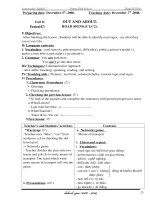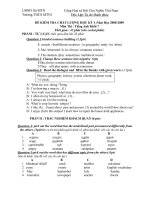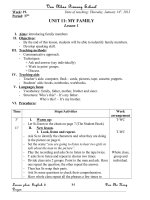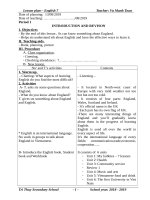Anh 7 mới - tuần 7
Bạn đang xem bản rút gọn của tài liệu. Xem và tải ngay bản đầy đủ của tài liệu tại đây (143.52 KB, 14 trang )
<span class='text_page_counter'>(1)</span><div class='page_container' data-page=1>
<b>Date of preparing: ... Period 19</b>
<b>UNIT 3: COOMUNITY SERVICE</b>
<b>LESSON 4 : COMMUNICATION (P. 31)</b>
<b>A. OBJECTIVES: </b>
- By the end of the lesson, students will be able to talk about volunteer activities for
teenagers in the US, the community service in VietNam and the benefits that each
activity may bring to the community.
+ Vocabulary: tutor ( n,v), shelter(n), nursing home (n), mural (a), blanket(n).
+ Grammar:
- Skills: Practice and develop speaking and writing skills.
- Political thought and moral sense: encourage Ss to take part in more volunteer
activities as well as the community service.
<b>B. TEACHING AIDS: .</b>
- Textbook, teacher’s book, lesson plan, board, chalks, and the projector.
<b>C . METHODS: </b>
- Chatting, matching,writing, write-it-up and interviewer.
<b>D. PROCEDURE: </b>
<b>I . Organization(1’) </b>
- Greeting
Class Date of teaching Absent students
B7
B8
<b>II. Revision(4’) </b>
<i><b>* Chatting</b></i>
? Have you ever taken part in any volunteer activities ?
? What are they ? / What did you do ?
? How often do you take part in these activities ?
? What was your feeling at that time ?
? How do you think about those activities ?
</div>
<span class='text_page_counter'>(2)</span><div class='page_container' data-page=2>
<b>III. New lesson:</b>
<i><b>Step 1: Vocabulary(10’)</b></i>
- tutor(n): người dạy kèm ( situation)
- nursing home(n): nhà dưỡng lão ( explanation)
- shelter(n): mái ấm, nhà tình thương ( translation)
- blanket(n): chăn ( picture)
- mural(n): tranh khổ lớn vẽ trên tường( được phép) (picture)
<i><b>+ Checking vocab: Matching</b></i>
- T asks Ss to match the words with their definitions/ explanations.
A B
1. tutor
2. nursing home
3. shelter
4. blanket
5. mural
a. Small private hospital, especially for old people
b. Pictures paitnted on the walls
c. Piece of thick clothes used as a warm covering on a bed
d. Fact of having a place to live or stay
f. Private teacher
<i><b>+ Answer keys: 1- f; 2 - a; 3 - d; 4 - c; 5 – b. </b></i>
<i><b>Step 2: Activity 2 ( Part 1- p.31) (15’)</b></i>
- T asks Ss to look at the photos and describe what they see.T numbers the pictures
from 1 to 6.
? Picture 1: What are they doing ? Are they allowed to do that? Are those pictures
useful?
? Picture 2: What are they bringing? Do you think who will receive them?
? Picture 3: What are these teenagers/ Ss going to do?
? Picture 4: What is that in the bowl?Who cooked it? Who received it?
? Picture 5: Where is it? What is the girl doing?
? Picture 6: Who is she? Is she teaching those children/ helping those children with
their homework?
<i><b>* Reading the text.</b></i>
- T sets the sence, then asks Ss to read the text silently.
- Let Ss match the pictures with the ideas from the text.
- T asks Ss to compare their ideas with the text.
</div>
<span class='text_page_counter'>(3)</span><div class='page_container' data-page=3>
<i><b>* Matching.</b></i>
- T sets the sence , then runs through the sentences by asking Ss to read loudly.
- T asks Ss what they think the volunteers in the photos are doing- T can draw Ss’
attention to small details in the photos, such as words written on the coupons, or in the
poster...to help Ss recognize the activities.
- Let Ss do the matching in the tables.
- T collects Ss’ ideas, corretcs.
<i><b>+ Answer key: 1- b, 2- c, 3- e, 4- a, 5- d.</b></i>
- T may ask if Ss know any other actual informationabout those volunteer activities, or
if they know any other similiar activities that take place in VietNam.
<i><b>Step 3:Activity 3 ( Part 3- p. 31)(12’)</b></i>
<i><b>* Discussion and writing </b></i>
- Let Ss work in groups of 5 and discuss the benefits that each activity may bring to the
community, then write on the posters in 3’.
- T gives the examples- let Ss work.
G1+ G2: Activity a.
G3+G4: Activity b.
G5 + G6: Acivity c
G7 + G8: Activity d.
G9 + G10: Activity e
- After that, T asks each group to send one person from their group to go to the board ,
show the poster and report back to class.
- T gives some suggestions.
“ We think that volunteering to give information in bus stations and railway stations”
can bring some benefits to the commmunity.First, it helps people know...
- T and WC give feedback.
<i><b>* Survey: </b></i>
- T asks Ss to go round the class, asks randomly 3 classmates about the activity they
want to try and why, then take notes.
- T models with a student:
</div>
<span class='text_page_counter'>(4)</span><div class='page_container' data-page=4>
A: Which activity do you want to try most?
B: I want to ...
A: Why do you want to do it?
B: Because I think it will...
<b>IV. Summary(1’) </b>
- T asks Ss to repeat the main contents of the lesson:
+ Volunteer activities in the USA.
+ The community service in VietNam and their benefits.
<b>V. Homework(2’)</b>
- Learn by heart all the vocabulary.
- Rewrite the ideas in part 4- p.31.
- Retell about your partner’s idea in part 5- p.31: Eg/ Hung wants to ....because...
- Do the exercises: 1, 2 in part C in the WB- p.21.
- Prepare the new lesson: Unit 3: Lesson 5: Skills 1
<b>* EVALUATION: </b>
...
...
...
<b>---Date of preparing: </b> <b>Period: 20</b>
<b> UNIT 3: COMMUNITY SERVICE</b>
<b>LESSON 5 : SKILLS 1 (P. 32)</b>
<b>A. OBJECTIVES: </b>
- By the end of the lesson, students will be able to understand the reading text and
know about volunteer work in the United States.
</div>
<span class='text_page_counter'>(5)</span><div class='page_container' data-page=5>
- Skills: Practice and develop reading and speaking skills.
- Political thought and moral sense: Ss know the ways to help their community.
<b>B. TEACHING AIDS: .</b>
- Textbook, teacher’s book, lesson plan, board, chalks, and the projector.
<b>C . METHODS: </b>
- Chatting, True or False , work in pairs, work in groups.
<b>D. PROCEDURE: </b>
<b>I . Organization(1’) </b>
- Greeting
Class Date of teaching Absent students
B7
B8
<b>II. Revision: </b>
<i><b>* Chatting(3’)</b></i>
? Have you ever done any of volunteer activities ?
? Why do you want to do them ?
<b>III. New lesson:</b>
<b>Step 1: Pre – Reading(12’)</b>
<i><b> Vocabulary:</b></i>
one – fifth : 1/5 ( example )
( to ) include : bao gồm ( explanation )
( to ) raise money : quyên góp tiền ( picture )
( to ) be forced : bị ép buộc ( translation )
Transportation ( n ) : phương tiện giao thông ( picture )
Check : Slap the board
<b>*T/F Prediction:</b>
<b> *True (T) or False (F).</b>
</div>
<span class='text_page_counter'>(6)</span><div class='page_container' data-page=6>
1. According to the text, nearly every American has done
volunteer work in his or her life.
<b>2. </b>Every year almost one in five Americans works as a
volunteer.
<b>3. Americans have been volunteering for less than 50 years.</b>
4. Americans volunteer because they are forced to do it.
-Teacher runs through the sentences.
-Teacher asks Ss to guess the meaning of the sentences without the book.
-Teacher asks Ss to guess the meaning of the sentences.then decide what the sentences
are T or F.
-Teacher models ( one sentence ).
-Let Ss do it.
-Ss do individually first, then compare with the partners.
-Teacher collects their ideas and writes on the board
<b>Step2 : While – Reading(17’)</b>
<b>Activity 1: </b>
<b>1. Read the text about volunteer work in the United States</b>
- Ss read the text and checks their guessing.
- Ss compare with the partners.
-Teacher collects and corrects.
Key:
<b>1. T</b>
<b>2. T</b>
<b>3. F ( The text says Americans have had the tradition of volunteering since the </b>
early days of the country. The USA was “ born”, or declared its independence ,
in 1776.)
4.F ( Americans volunteer because they enjoy it , and not because they are forced or
paid to do it.
</div>
<span class='text_page_counter'>(7)</span><div class='page_container' data-page=7>
-T asks Ss to read the passage again and answer the questions.
Which of the activities below are traditional volunteer activities in the United States? Tick in the
boxes.
1, providing care for animals
2. raising money
3. cooking meals
4. donating blood
5. cleaning streets
6. teaching young children
-Teacher runs through the activities in the table.
-Teacher models
-Let’s Ss work individually
-Then Ss compare with their partners
-Teacher collects and corrects.
<b>KEY:</b>
1, providing care for animals
2. raising money V
3. cooking meals V
4. donating blood
5. cleaning streets V
6. teaching young children V
<b>Step 3 : Post – Reading(8’)</b>
<b>Speaking:</b>
<b>Activity1: Exercise 4</b>
<b> Idea bank: Fill in the table with your ideas for volunteer activities.</b>
To raise money,
we could…
To provide food,
we could…
To help repair
things we
could...
To help people
With
transportation,
we could…
To tutor young
children, we
could…
Make postcards
and sell them
</div>
<span class='text_page_counter'>(8)</span><div class='page_container' data-page=8>
children
-Teacher gives time for Ss to work individually to complete this task.
-Teacher encourages Ss to think of all the volunteer activities they have learnt so far in
this unit, and any other activities that they know.
-Ss only need to write in note form and not full sentences.
<b>Activity2:</b>
-Divide the class into groups of four or five
-Explain that after each person shares his or her ideas from exercise 4 ,the group will
need to choose one idea and develop it in more detail.
-Let Ss do it.
-Ss work in groups.
-Ss share the ideas in their idea bank with their group members.
-Then,Ss use the most interesting ideas to create a new group idea bank and share
it with the class.
-Teacher calls some students to talk in front of the class ( Ss give their ideas ... ).
<i><b>Example:</b></i>
Student A: We could make postcards and sell them to raise money.
Student B: What types of postcards?
Student C: Who can make the postcards?
Student D: What is written on the postcards ?
Student E: Where should we sell them?
<b>IV. Summary(1’)</b>
- T asks Ss to repeat the main contents of the lesson:
+ Volunteer work in the United States
<b>\V. Homework(2’)</b>
- Learn by heart all the vocabulary.
- Rewrite the ideas in part 4- p.31.
</div>
<span class='text_page_counter'>(9)</span><div class='page_container' data-page=9>
- Do the exercises in part C in the WB- p.21.
- Prepare the new lesson: Unit 3: Lesson 6: Skills 2
<b>* EVALUATION: </b>
...
...
...
<b>Date of preparing:</b> <b>Period 21</b>
<b>UNIT 3: COMMUNITY SERVICE</b>
<b> LESSON 6 : SKILLS 2 (P. 33 )</b>
<b>A. OBJECTIVES: </b>
- By the end of the lesson, students will be able to know about the benefits of the
volunteer work and use linking words “because” to join ideas and give reasons.
+ Vocabulary: confident ( a ) , ( to ) raise funds, Special ( a ) , Reason ( n )
+ Grammar:
- Skills: Practice and develop listening and writing skills.
- Political thought and moral sense: Ss know the benefits of the volunteer work and
the ways to help their community.
<b>B. TEACHING AIDS: .</b>
- Textbook, teacher’s book, lesson plan, board, chalks, and the projector.
<b>C . METHODS: </b>
- Chatting, answer the questions , fill in the blanks, write it up...
<b>D. PROCEDURE: </b>
<b>I . Organization(1m) </b>
- Greeting
</div>
<span class='text_page_counter'>(10)</span><div class='page_container' data-page=10>
B8
<b>II. Warm up(4’)</b>
.Brainstorming:
- T draws the net on the board.
- T gives the instructions: write down the benefits of volunteer work ( one student one
word ).
- T models the first one.
Help the poor people
- T checks Ss' understanding.
- Ss think and prepare in about 1 minute.
- T calls Ss to go to the board and write down.
- One student one word.
- T corrects then praises
<b>III. New lesson:</b>
<b>Step 1: Listening ( 17’)</b>
<i><b> Vocabulary:</b></i>
Confident ( a ) : tự tin ( explanation )
( to ) raise funds: gây quĩ ( picture )
Special ( a ) : đặc biệt ( translation )
Reason ( n ) : lý do ( explanation )
Check : rub out and remember
<b>*Discuss the following questions</b>
- Who do you think benefits from volunteer work?
The benefits of
Volunteer work
</div>
<span class='text_page_counter'>(11)</span><div class='page_container' data-page=11>
- How do people benefit from volunteer work?
-T gives the questions
-Tasks Ss to discuss the questions and answer the questions.
-Ss work in groups.
-T asks some Ss to talk in front of the class.
T’correction
<b>Activity 1 : Ss listen to the recording and answer the questions</b>
1. Why does Phuc do volunteer work?
2. Why does Phuc feel more self-confident?
3. Why does the reporter think Phuc is confident?
4. Why does Mai think volunteering is special?
-T shows the questions.
-T runs through the questions.
-T plays the recording.
-Let Ss listen to the recording and answer the questions
-Ss do individually, then compare with the partners
-T collects and corrects.
<b>Key :</b>
1. Phuc does volunteer work because he thinks it makes a difference in the
community.
2. Phuc feels more self – confident because he has made many friends.
3. The reporter thinks Phuc is confident because Phuc has answered the interview
questionsvery well.
4. Mai thinks volunteering is special because she can help others , and because she can
see how happy the street children are when they learn.
<b>Tapescipt:</b>
</div>
<span class='text_page_counter'>(12)</span><div class='page_container' data-page=12>
Phuc : I volunteer because it makes a difference in our community. We can encourage
pepple to protect the environment and our community will be a better place.
Reporter : Do you think volunteering is good for yourself too ?
Phuc : Oh yes, I’ve made many new friends, and I feel much more self – confident.
Reporter : I agree. You’ve answered the interview very well....And you Mai ?
Mai : Volunteering is special to me because I can help others. It’s special because I can
<b>see how happy the children are when they learn.</b>
<b>Activity 2</b>
<b>Listen again and fill in the blanks.</b>
1. I __________because I can make a difference in our community.
2. I've made many new friends, and I _________much more self-confident.
3. Volunteering is special to me _________I can help others.
4. It's special ___________I can see how happy the __________are when they
learn.
-T runs through the sentences.
-T models.
-T plays the recording and let Ss listen and fill in the blanks.
-Ss do individually
-Then compare with the partners.
-T collects and corrects
Key:
<b>1.volunteer 2.feel 3.because 4. because , children</b>
<b>Step 2: Writing(20’)</b>
<b>Activity1</b>
<b>-T goes through the Study Skill box with the class.</b>
-T explains that ‘because’ is used to introduce the reason for something , and it can be
put at the beginning of the sentences or in the middle.
</div>
<span class='text_page_counter'>(13)</span><div class='page_container' data-page=13>
Giving reasons for your ideas and opinions makes your speaking and writing more
interesting and convincing.
<i>Example: I volunteer because it makes a difference in our community.</i>
<b>Remember! </b>
-T runs through the Remember box with the class.
-T asks Ss to take note and remember the way to use ‘because’.
<b>We can use linking words (e.g. because) to join ideas and give reasons.</b>
<i><b> Clause 1 + because + Clause 2 (reason)</b></i>
<i> I like her because she's kind.</i>
<i><b> Because + Clause 2 (reason), + Clause 1 </b></i>
<i> Because she's kind, I like her.</i>
-Let Ss do exercise 4
-Ss do individually , then compare with the partner
-T calls Ss to do in front of the class.
-T’correction
<i><b> Exercise 4. Combine the two sentences using because.</b></i>
<b>Key:</b>
<b>1. Because he didn't wear enough warm clothes, he's had a cold for two days.</b>
<b>2. I stayed home because it rained.</b>
<b>3. Because the lake is full of rubbish, they've decided to clean it up.</b>
<b>4.Because she works in that small town, she's lived in that small town for three years.</b>
<b>5. They think they should move there because the neighbourhood is nice and quiet. </b>
<b>Activity 2: </b>
<b>Exercise 5</b>
<b>-Task Ss to look at their volunteer ideas in Speaking 4. </b>
<b>- Ss choose one idea and write a short paragraph about it.</b>
- What do you want to do?
</div>
<span class='text_page_counter'>(14)</span><div class='page_container' data-page=14>
- How are you going to do it?
<i><b>Example:</b></i>
<i>I want to raise funds for street children. I want to do it because we will be able to </i>
<i>provide them with food and 6oohs. They will no longer be hungry. They will be able to </i>
<i>read. 1 will ask my friends to help me. We will make postcards and sell them.</i>
-Let Ss do it.( work in groups ; write on the posters ).
-Tcollects and corrects.
<b>IV. Summary(1’) </b>
- T asks Ss to repeat the main contents of the lesson:
+ The benefits of the volunteer work
<b>V. Homework(2’)</b>
- Learn by heart all the vocabulary.
- Do exercise 4 , 5- p.33
- Do the exercises in part D in the WB- p.24- 25
</div>
<!--links-->









